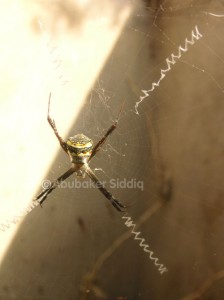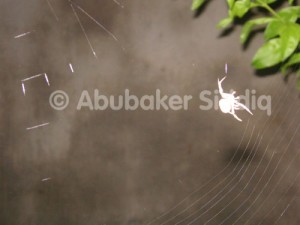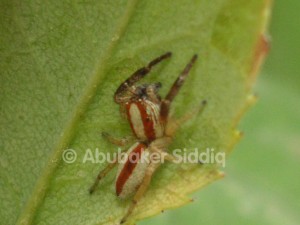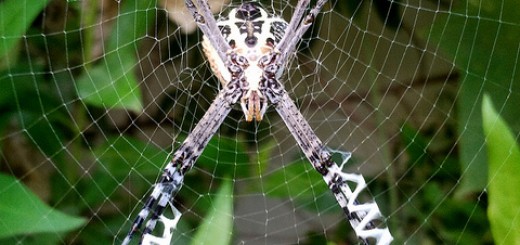If you want to live and thrive, let a Spider run alive
Have you ever noticed some webs at the corner of the walls that you just carelessly sweep away or sometimes just tired of these bugging webs invading in your beautiful and clean house? I am sure you have not noticed how expertly these webs are spun? Who spins them?
Spiders; A group of invertebrates which are found throughout the world from the sea shores or from the zones where splashes reach to the hot sands of the deserts. The spiders have 40,000 species throughout the world out of which I have seen almost twenty species in my house and garden.
People think that it’s just a small insect making webs. But you would find it funny to know that Spiders are NOT insects! They belong to the class of arthropod, arthropods are any of a large group of invertebrates, and invertebrates are animals without backbones that have spinning glands used to produce silken threads and webs. Spiders have eight legs while the insects have six legs and an antenna.
BODY PARTS:
Their body consists of two parts: fused head and thorax (cephalothoraxes), and an abdomen. The fused head has two fangs which they use to capture their prey. They have eight legs out of which each leg is controlled by more than 30 muscles. We all know this fact that spiders have 8 legs and they are called the 8 legged insects. Hang on there..Spider just not have 8 legs, they have 8 eyes. I was surprised to know this fact but then while observing some of the Spiders in my garden, I confirmed this fact. Spiders have hairs on their feet which they use to taste things. Yes they taste from with help of their feet. The mysterious web is is produced from the back part of the abdomen that is called Spinneret. Not from the hands like of ‘Spider Man’.
SIZE AND COLOUR:
Spiders range in sizes from less than 1.0 mm to more than 10 cm in length, with a leg span of up to 20 cm. Camels can store water for weeks in their hump but they are so large while spiders are so small but they can store food in their extensive digestive system for weeks or even months without the need to catch any prey.
Spiders are found in almost every color. I have seen a spider with red, black, brown, grey, and yellow color in a magnificent pattern. (See picture below: Spider in a gutter in near my house).

Spider in a gutter near my house
RESPIRATION AND DIGESTIVE SYSTEM:
Another unique feature of spiders is that they can respire from two distinct respiratory organs that are trachea and book lungs.
Spiders have an unusual way of digestion that begins outside their body. When they catch their prey, they use its venom to paralyze the prey through their sharp fangs and then they vomit juices containing digestive enzymes into the wound of the victim to break down and liquefy its body tissue. This liquefied tissue is then drawn through their mouth and into their body by the sucking action of the stomach. Two mechanical filters in the mouth prevent solid food particles from passing into the digestive system.
BRAIN:
A spider’s brain is relatively highly developed, enabling spiders to easily adapt to changes in their environment. Some species use their sense of touch and brain more than their eyesight which is not well-established when they are young.
SILK GLANDS:
Nearly all spiders produce silk composed of the protein fibroin, same protein produced by silkworms. Each spider has four to eight different kinds of silk glands in its abdomen, and each gland produces a different type of silk with different properties. For instance, the cocoon produced by the gland is different from the silk gland that they use to catch prey.
WEB:
Web patterns vary considerably, depending on the species of spider. Perhaps the most recognizable web is the circular orb web, in which an outer framework supports a continuous spiraling thread and a series of threads radiating from the center of the web. You might have seen this one in garden. Some spiders build irregular, flimsy webs. Common house spiders construct funnel webs, flat silk sheets with a raised tube in the corner that serves as a retreat for the spider. Cobweb spiders build an irregular silk meshwork with sticky threads at the bottom that trap insects.
The size of a web depends on the size of the spider. Whether the web has a tight or wide mesh depends on the size of the prey the spider expects to capture. Spiders usually build their webs at night, completely relying on their sense of touch. I also saw spiders making web at night. I have observed that they can complete their web building in less than 30 minutes if wind is not blowing. It was my first attempt to capture the web making process back in 2004 and it was successful. Here is the shot that I took of a Spider building its web in my garden at night.

A Spider making web at night – at the Spider’s Garden
Notice the time when the spider is in the process of weaving its web, it will remind you of the old lady who spins cotton on the moon or your grand mother knitting sweaters. Another interesting thing which I observed is that their silk gland is not just a single thread; it is composed of more than one silk thread. It is like three or four different threads twisted together. This strengthens the web.
TYPES OF SPIDERS:
The spiders are organized according to their hunting ability. There are two types, Web spiders and Ground spiders. Web spiders use web to capture prey while ground spiders wait for prey to come near and then pounce and kill the prey with their strong chelicerae (fangs). The ground spiders also include jumping spiders which depending on species can leap up to 25 times their body length. Species of large spiders can deposit several thousands eggs within just few minutes. Once I saw in my garden, an egg of the size of a moth ball. When I inspected closely, I saw hundreds of tiny (1mm in size) spiders coming out of the egg in a row on a single web thread. They were crawling the web in a queue. Flower spiders or the Golden rod are commonly found on the Rose plants. They are different in colors such as white, yellow, light green. Once I found a white colored Golden Rod spider and took its picture. You can see the picture below.

A white Golden-Rod Spider on a rose flower
I have found and inspected around 25 different species of Spiders in my house and in my garden.
WHAT TO DO WHEN YOU SEE SPIDERS:
If you see a spider, don’t panic even if it’s a big one. This is the chance of observing and taking pictures. And don’t try to kill it and let it go outside if it’s in a room or leave it if it’s outside.
Spider bites are not dangerous to humans. But don’t get yourself bitten by spider because it won’t transform you in Spider-Man. Of the 40,000 species of spiders, only about 30 species produce bites that may cause illness. Spiders rarely attack humans unless they feel threatened, and if they do bite, the wound is rarely serious. Some of the spiders most dangerous to humans are the black widow, the brown recluse, the Australian funnel web spider, and the South American hunting spider.
WHEN AND WHERE TO FIND SPIDERS:
In summers spiders usually come out from their homes for hunting. In winter, they may come out in day but in summer they come out in night to make their magnificent circular orb web. The Golden rod spider is found on many flowering plants and is white in color. It is not dangerous so if you want to play with it you can.
Jumping spiders are also found on rose plant. Another way of finding a spider at any place is if web of any kind whether circular orb or an irregular web is present, there should be a spider there. Or there have been a Spider living over there.
IMPORTANCE OF SPIDERS:
Each year spiders consume as much as 100 kg of dangerous insects for plants per 1 hectare of land. The spider was the one who helped Hazrat Muhammad (PBUH) by its flimsy web in the cave of ‘Saur’ when the enemy was trying to kill him at the time of Hijra. A Surah ‘“Al-Ankabut” in Holy Qur’an is named after Spider.
Try finding spiders if you are interested and you will find the research fascinating.
You will see that they can fly using their web. They can throw web to a long distance on the desired location and may walk on it or pull themselves. Once again do not kill the spider, because you never know one of them might bite you and you become the next Spiderman!!!!
I am putting another picture, the one which is the best picture that I have captured. I have made this picture as my profile picture for Facebook, MSN, MySpace, Twitter, and Gmail and on many other websites.
Looking for more photos captured by me?
You can find complete album of my Spiders here:
https://www.facebook.com/pg/Abubakershekhani.artist/photos/?tab=album&album_id=839969299493791
This is the article that I wrote in 2006 and it was published in DAWN – Young World in Feb 2007. I am posting here the original article with some pictures that were not added at that time.



